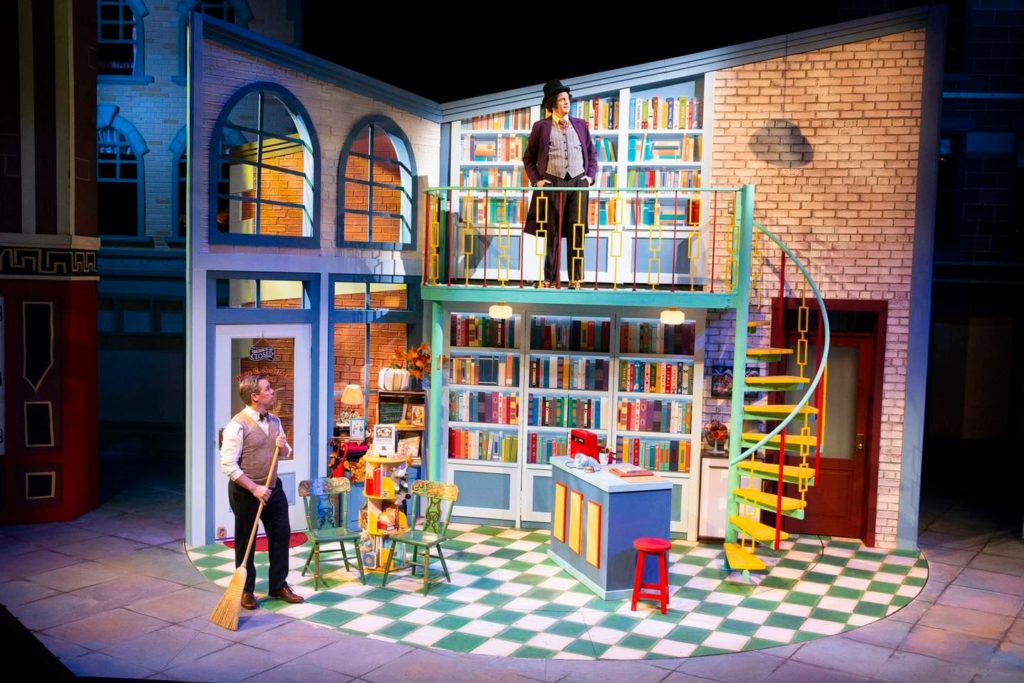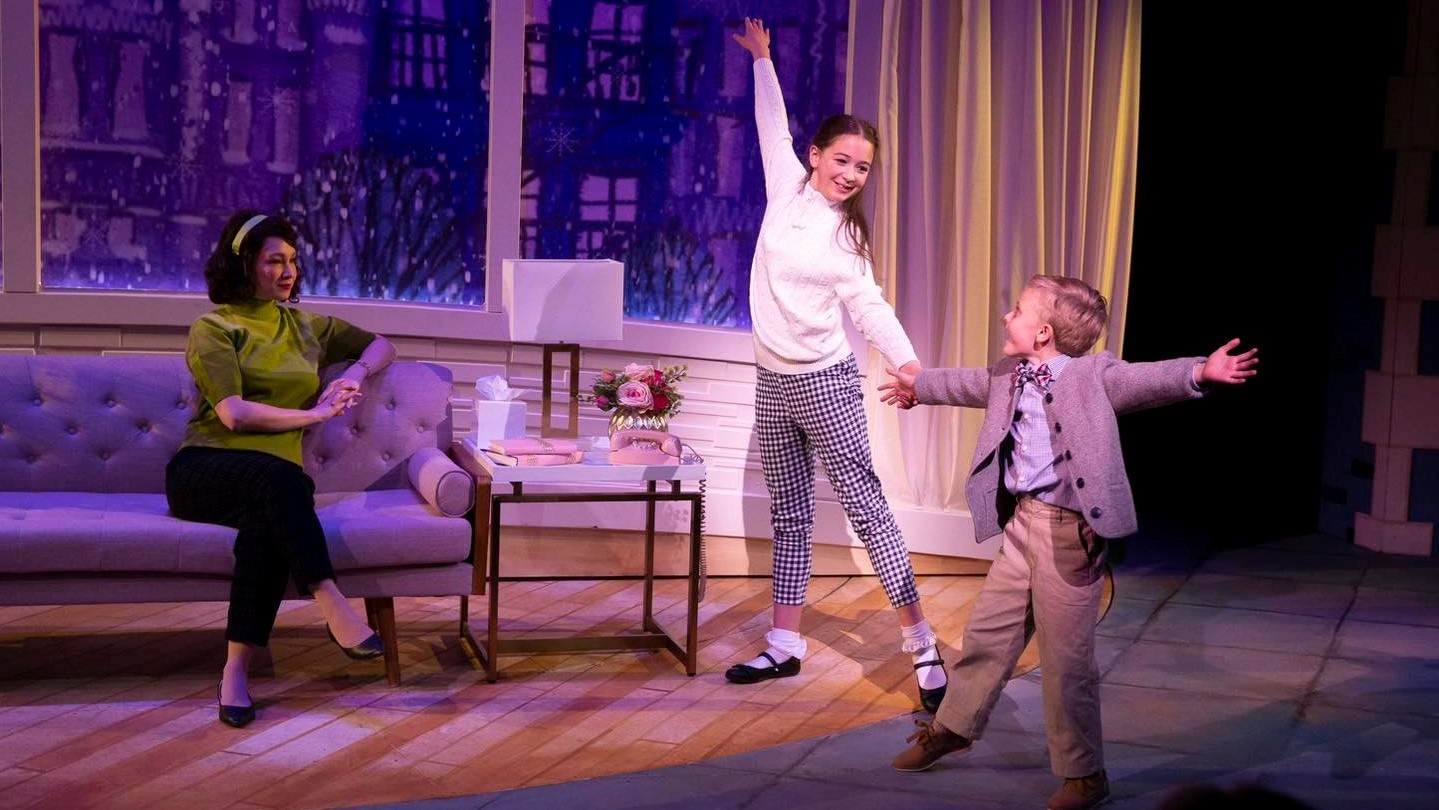SANDY — When a story is revised, revived or adapted from one medium to another, there’s always a purist or two who resists the changes from the original version. Prior to seeing Hale Centre Theatre’s world premiere of Hans Christian Andersen in New York, with music and lyrics by the late Frank Loesser and book by Paul Blake, I did not realize there was original source material for this text. Beyond being familiar with the fables of Andersen, I did not have expectations for a story, music or characters. I had not at that time seen the 1952 film Hans Christian Andersen, which Losser had originally composed the music for. Even so, the story and script were an immense disappointment, and the play was not rescued by odd directing choices, stilted acting, or music that had been given a garish brassiness that felt one-note and hurried.

The story begins with downcast Hans Christian Andersen, not the celebrated author, but his invented descendant of the same name, who is living in New York City in 1962. This Hans is a failed Broadway actor whose aunt has died and foisted upon him a struggling property that is half bookstore and half dance studio run by his best friend Bunny Bailey. Hans is struggling to sell any books, and Bunny insists that he occupy himself with putting on a show for the children of her studio. He resists until his ancestor of the same name bursts through a mirror like the phantom of the opera dressed in a Willy Wonka jacket declaring he must produce a children’s play to save the store and possibly himself.
The rest of the story follows a series of unmotivated, melodramatic tropes with songs from the original film shoehorned awkwardly into the show. Bunny and Hans both fall in love with the first adults of the opposite sex that they meet. The children’s show is going to be canceled because Hans can’t pay the rent. Fortunately, a miracle benefactor eventually arrives. Hans’s love interest Nancy is offended by him and takes her children out of the show, but her heart softens when her children perform a number Hans taught them that had been a planned secret, and she returns to save the show.
These choices led to a pair of problems. First, the tropes were poorly spliced together and did not merit any emotional response from the audience. Second, some of the sequences included seriously off-putting situations and dialogue. Nancy is offended by Hans because he has gone behind her back and put her son into the show when Nancy expressly told him not to for justifiably sound reasons. Hans takes exception to her desire to parent her children how she wishes and seeks to guilt her into accepting his influence by saying that she is damaging her children and others. When the rent collector comes to collect on six months unpaid rent, he is told by Bunny and Nancy “but you can’t close us down at Christmas!” The rent collector turns on his heels and shouts, “Happy Hanukkah” in an ad lib from the actor which read as a deeply anti-Semitic stereotype.
At another point, Hans’s showbiz partner Bobbie Tone, who is the worst possible stereotype of a tyrannical dance instructor, quits the show. Hans is desperate for a new director. He rattles off a list of qualities he will need in a director, which seem to indicate Bunny, but Hans and his ghostly ancestor declare with conviction that only he can save the show. Catchphrases that did not payout were sprinkled into the show, and there were many jokes that, whether from writing, delivery or direction, simply did not land. Even the best new productions require immense revising after they are staged, but there are simply things about the script, characters and story that need to be entirely reimagined from Hans Christian Andersen in New York.
Dave Tinney’s direction, while supporting strong musicality, missed key features of characters that led to moments falling flat. Bunny’s love interest is a man named Harry Porter who infuriates others because he is often referred to as bumbling and clumsy. However, I did not notice a single instance of him being careless, and the one high-stakes moment where a character is graceless, Harry saves Bunny from what would have been a nasty fall by being coordinated. As I mentioned in my review for HCT’s See How They Run, I felt again that in the name of pacing, jokes were blitzed through and not given a chance to breathe or land with the audience. Actors often indicated that a joke was coming but did not break the fourth wall directly. It led to punchlines that were deflating and comedy that just did not stick. In many instances, the difference between a good joke and a bad joke is timing. The timing and inflection needed for good jokes in this production was often missing. The same can be said for building tension in emotional moments. Actors struggled to develop chemistry, and this was often because the production felt rushed.
Despite the challenges for the actors to overcome, I came away thrilled with Korianne Johnson’s portrayal of Bunny. Johnson played Bunny with a vitality that single-handedly carried the show. While her character’s infatuation with Harry Porter is at times confusing, Johnson’s ability to playfully seduce her character’s counterpart as he blustered against her advances was charming. Her voice had a rich tone that made songs like “How’dja Like to Love Me?” recapture magic that was quickly fading from the theatre. Similarly, Ashley Carlson leaned strongly into the forceful Bobbie Tone. Carlson commanded the stage and her personality swallowed up the “amateur” children that her character so often railed against. She was a truly convincing diva and seemed to relish the insults she hurled at Hans, Bunny, Harry and the children. It was the kind of performance that required me to remind myself that she is an actor and probably a very likable person when out of character. By contrast, Alex King who played the titular character felt like an animatronic in the first part of the play. King rarely brought likeability to the character. He was brazen and petulant when reconciling with Nancy, and he seemed smug rather than sincere interacting with Bunny and the children.
As is the norm for Hale Centre Theatre shows, the production values were splendid to behold. Jenn Taylor’s rotating set on the Sorenson Legacy Jewel Box Stage was stunning. The backstage façade masked live musicians in New York Apartments. The colors were vibrant, and the entrances for the ghost of the elder Hans were woven seamlessly into the set. I walked into the house, saw the set and could only utter a “wow.” It was one of the show’s few supremely strong points.
Perhaps the most damning thing about the entire production was how much of the story spit in the face of theatre makers of all kinds. Hans’s initial concern for a show with children was that he could not afford pretty costumes and sets. He later said that a stage manager does nothing but point — something I would have been bothered by if I had been the PSM of this exceptionally well stage managed production. The teachers are never reprimanded for being harsh to children. The final production’s focus more on the adults than the children who add little other than token cuteness to the story. I would not want to have my child participate in a theatre camp at a theatre that produced this show because it seemed to belittle the concerns of parents and the value of creative and compassionate theatre makers.
Suffice it to say, I walked away unimpressed by this production. It was the first time I had attended a Hale performance where no one gave a standing ovation, and I felt that the show merited the audience staying in their seats. It would be crushing and dispiriting to work as hard as this cast and crew clearly have to produce a show that misses the mark on so many sides. I watched the 1952 film the day after seeing this to see if there was something I had missed in understanding what this new production had become. Instead, I became more saddened that the kind and gentle Hans of that story never made it to this one. I was frustrated that such a beautiful score by Loesser had been zhuzhed up unnecessarily to have a pop sound that lost the intricacies of the music. Drawing on a fable master that had such masterful themes and then to walk away with confusing or grating messages in this production was a costly mistake which I hope is amended in the next version of this story.
[box]Hans Christian Andersen in New York plays at Hale Center Theatre 9900 Monroe Street Sandy, UT on May 8 through July 15, 2023 on Monday through Saturday at 7:30 PM with matinees on Saturdays at 12:30 PM & 4:00 PM. Tickets are $18-$63. For more information, visit hct.org.[/box]

